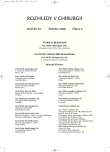Chronic Wound as a Precancerosis (Ulcus Marjolini – Marjolin‘s Ulcer) – A Case Review
Authors:
T. Toporcer 1; L. Lakyová 1; Ľ. Babjaková 2; M. Zábavníková 3; J. Belák 1; J. Radoňak 1
Authors‘ workplace:
II. chirurgická klinika, Lekárska fakulta Univerzity P. J. Šafárika, Košice, Slovenská republika
prednosta: MUDr. J. Belák, Ph. D.
1; Ústav patológie, Fakultná nemocnica L. Pasteura, Košice, Slovenská republika
prednosta: prof. MUDr. A. Böör, CSc.
2; Klinika plastickej, rekonštrukčnej a estetickej chirurgie, Lekárska fakulta Univerzity P. J. Šafárika
Košice, Slovenská republika, prednostka: MUDr. M. Zábavníková, Ph. D.
3
Published in:
Rozhl. Chir., 2008, roč. 87, č. 6, s. 317-321.
Category:
Case Report
Overview
Marjolin’s ulcer is defined as a tumor arising from a chronic wound, scar or chronic inflammation. Commonly, it is histologically diagnosed as a squamous cell carcinoma or a basocellular carcinoma. Its management includes its excisioning including a sufficient circumferential rim and histological examination of the sentinel lymphnode.
The authors present a case review of a 51-year-old male with a history of a sacral decubitus, treated for over 40 years. The patient was hospitalized to cover the defect with a skin flap. During the hospitalization, histological examinations of his inguinal lymphnodes and subsequent wound granulations were performed with an identical finding of a squamous cell carcinoma. Based on the findings, the Marjolin’s ulcer was diagnosed. The patient underwent the first series of chemotherapy. However, the patient’s condition deteriotated. He exited 24 days following establishment of the diagnosis.
The aim of this study is to highlight one of the most dangerous complications of chronic wounds. Marjolin’s ulcer is a diagnosis, which must be considered in any chronic wound of any etiology, persisting for over 3 months.
Key words:
ulcus Marjolini – Marjolin’s ulcer – decubitus – decubital ulcer – chronic wound – squamous cell carcinoma – carcinogenesis – precancerosis
Sources
1. Yuste, G. P., Villarejo, C. P., Menendez Rubio, J. M., Garcia, G. A., Perez, V. E., Gambi, P. D., Martinez Pueyo, J. I., Cruz, V. F. Marjolin‘s ulcer arising from a laparostomy scar. Int.Surg., 2006, roč. 41, č. 4, s. 207–210.
2. Kowal-Vern, A., Criswell, B. K. Burn scar neoplasms: a literature review and statistical analysis. Burns, 2005, roč. 17, č. 4, s. 403–413.
3. Etufugh, C. N., Phillips, T. J. Venous ulcers. Clin. Dermatol., 2007, roč. 25, č. 1, s. 121–130.
4. Copcu, E., Aktas, A., Sisman, N., Oztan, Y. Thirty-one cases of Marjolin‘s ulcer. Clin. Exp. Dermatol., 2003, roč. 28, č. 2, s. 138–141.
5. Sabin, S. R., Goldstein, G., Rosenthal, H. G., Haynes, K. K. Aggressive squamous cell carcinoma originating as a Marjolin‘s ulcer. Dermatol. Surg., 2004, roč. 10, č. 2, s. 229–230.
6. Kozlowsky, P. Surprisingly quick development of squamous cell carcinoma in chronic skin ulcer. Chir. Narzadow Ruchu Ortop. Pol., 2004, roč. 77, č. 1, s. 45–48.
7. Asuqo, M. E., Nwagbara, V. Marjorlin‘s ulcer presenting as pathological fracture. Niger. Postgrad. Med. J., 2007, roč. 14, č. 3, s. 266–268.
8. Czarnecki, D., Nicholson, I., Tait, B., Nash, C. HLA DR4 is associated with the development of multiple basal cell carcinomas and malignant melanoma. Dermatology, 1993, roč. 2, č. 1, s. 16–18.
9. Hayashi, M., Tamura, G., Kato, N., Ansai, S., Kondo, S., Motoyama, T. Genetic analysis of cutaneous squamous cell carcinomas arising from different areas. Pathol. Int., 2003, roč. 10, č. 9, s. 602–607.
10. Garcia-Morales, I., Perez-Gil, A., Camacho, F. M. Marjolin‘s ulcer: burn scar carcinoma. Actas Dermosifiliogr., 2006, roč. 98, č. 8, s. 529–532.
11. Bernstein, S. C., Lim, K. K., Brodland, D. G., Heidelberg, K. A. The many faces of squamous cell carcinoma. Dermatol. Surg., 1996, roč. 2, č. 3, s. 243–254.
12. Ratliff, C. R. Two case studies of Marjolin‘s ulcers in patients referred for management of chronic pressure ulcers. J. Wound. Ostomy. Continence. Nurs., 2002, roč. 9, č. 5, s. 266–268.
13. Kim, J. M., Su, W. P., Kurtin, P. J., Ziesmer, S. Marjolin‘s ulcer: immunohistochemical study of 17 cases and comparison with common squamous cell carcinoma and basal cell carcinoma. J. Cutan. Pathol., 1992, roč. 19, č. 4, s. 278–285.
14. Reich, A., Cisło, M., Szepietowski, J. C. Squamous Cell Carcinoma Arising in Long Lasting Leg Ulceration. Čes.-slov. Derm., 2006, roč. 80, č. 6, s. 290–292.
15. Knudsen, M. A., Biering-Sorensen, F. Development of Marjolin‘s ulcer following successful surgical treatment of chronic sacral pressure sore. Spinal Cord., 2007, roč. 12, č. 3, s. 239–240.
16. Impola, U., Jeskanen, L., Ravanti, L., Syrjanen, S., Baldursson, B., Kahari, V. M., Saarialho-Kere, U. Expression of matrix metalloproteinase (MMP)-7 and MMP-13 and loss of MMP-19 and p16 are associated with malignant progression in chronic wounds. Br. J. Dermatol., 2005, roč. 55, č. 4, s. 720–726.
17. Aydogdu, E., Yildirim, S., Akoz, T. Is surgery an effective and adequate treatment in advanced Marjolin‘s ulcer? Burns, 2005, roč. 17, č. 4, s. 421–431.
18. Kim, N. G., Lee, K. S., Choi, T. H., Kim, J. S., Choi, J. H., Jang, P. Y., Han, K. H., Son, D. G., Kim, J. H. Aesthetic reconstruction of lower leg defects using a new anterolateral lower leg perforator flap. J. Plast. Reconstr. Aesthet. Surg., (2007), doi:10.1016/j.bjps.2007.06.006, (article in press)
19. Bauer, T., David, T., Rimareix, F., Lortat-Jacob, A. Marjolin‘s ulcer in chronic osteomyelitis: seven cases and a review of the literature. Rev. Chir. Orthop. Reparatrice Appar. Mot., 2007, roč. 57, č. 1, s. 63–71.
20. Chraibi, H., Dereure, O., Teot, L., Guillot, B. The diagnosis and treatment of carcinomas occurring at the sites of chronic pressure ulcers. J. Wound. Care, 2004, roč. 13, č. 10, s. 447–448.
Labels
Surgery Orthopaedics Trauma surgeryArticle was published in
Perspectives in Surgery

2008 Issue 6
Most read in this issue
- Short Bowel Syndrome and Limits of Small Intestinal Resections
- Cystic Feochromocytoma, Mimicing a Liver Cyst. A Case Review
- Ventral Hernia Associated with Morbid Obesity – When Is Surgery Indicated?
- Miniinvasive Surgery in Spontaneous Pneumothorax – Indications and Surgical Technique
